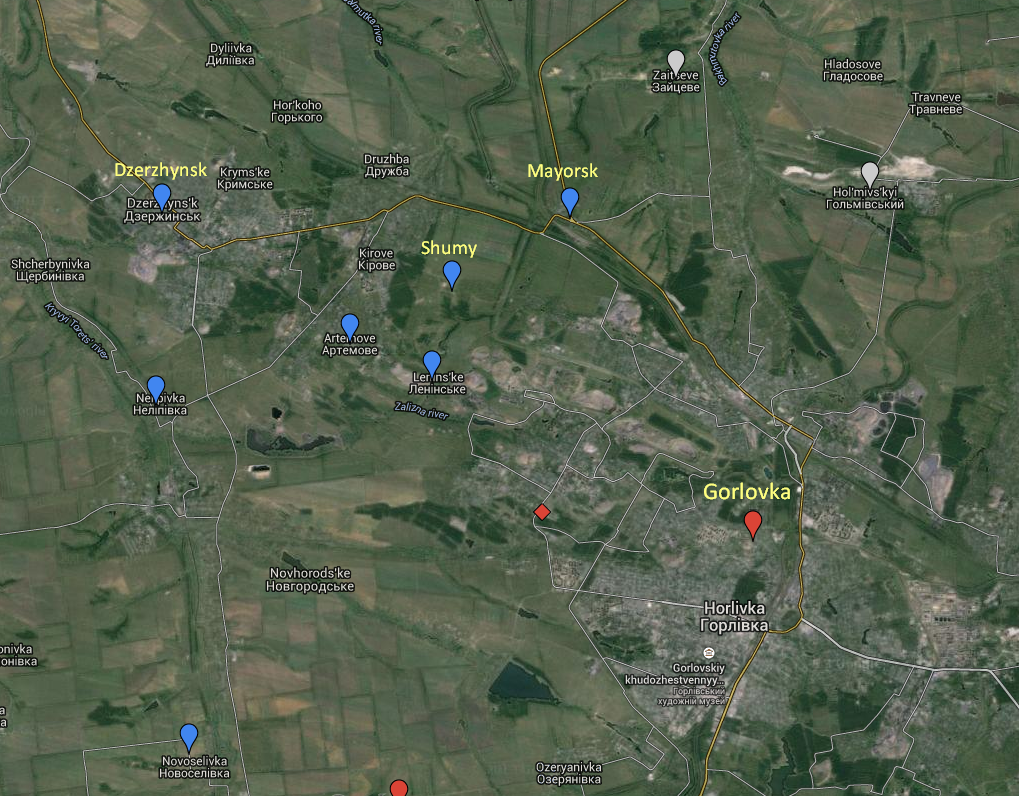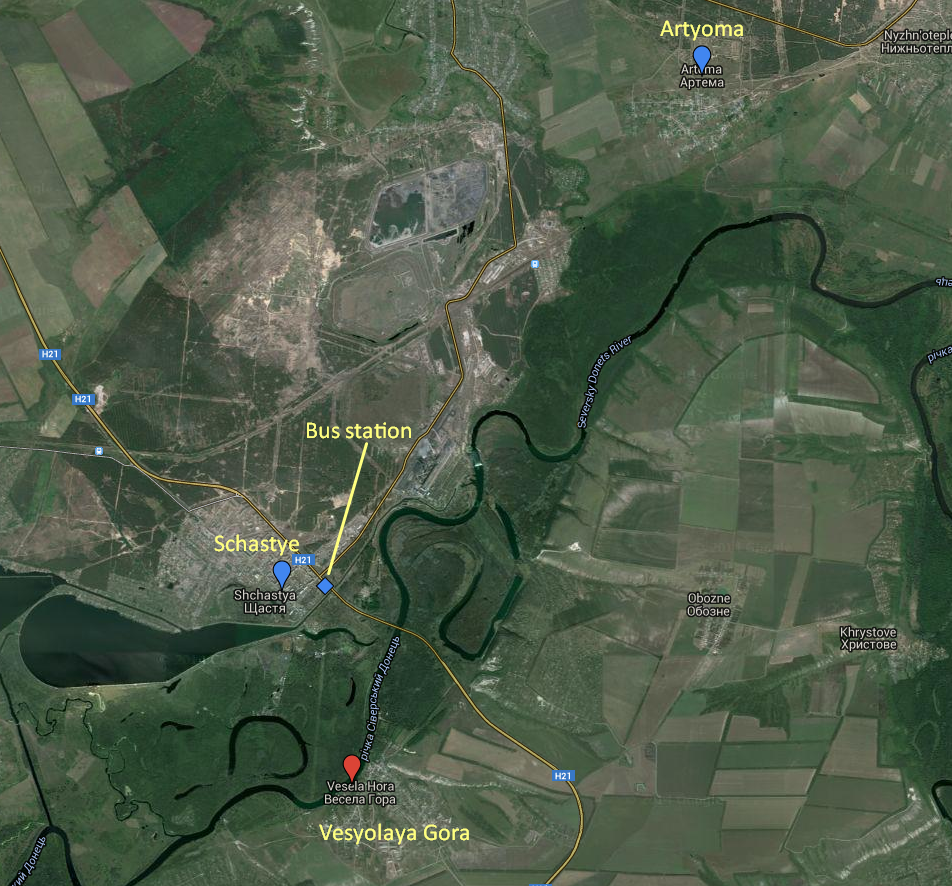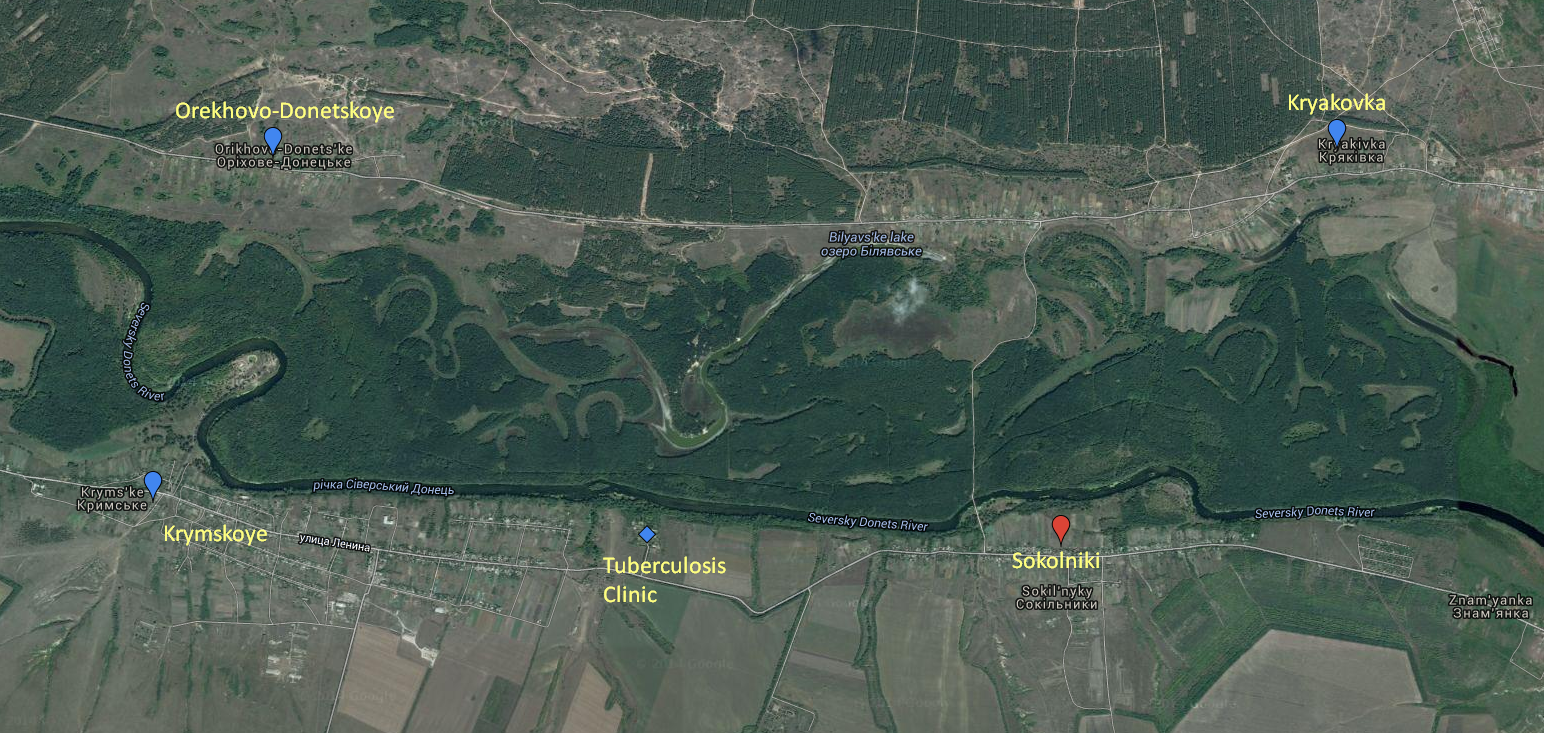Yesterday’s live coverage of the Ukraine conflict can be found here. An archive of our liveblogs can be found here. For an overview and analysis of this developing story see our latest podcast.
Please help The Interpreter to continue providing this valuable information service by making a donation towards our costs.
For links to individual updates click on the timestamps.
For the latest summary of evidence surrounding the shooting down of flight MH17 see our separate article: Evidence Review: Who Shot Down MH17?
There are reports of fighting in Novoluganskoye and Golmovsky, between Gorlovka (Horlivka) and Svetlodarsk.
Translation #Gorlovka Zello Supposedly shelling observed from the direction of Zaytsevo on Golmovsky. Flashes of explosions visible.
Translation: #Gorlovka “Fighting toward Novoluganka” “Fighting from Golmovsky toward Svetlodarsk. Much closer to Svetlodarsk.”
Translation: 22:25 Emergency shut-off of electricity, a
Translation: Artyomovsk about 2 hours ago, Sanitarny Mi-8. Flew over the center, ver low. Picked up wounded, about 2 hours ago ambulances brought.
This tweet includes a screenshot of a report from journalist Roman Burko, which The Interpreter has translated:
Volunteer friends report. Help is needed. There are a lot of wounded: “It has begun all along the front! A lot of 300s, 200s, already more than 20 counted…confirmed — Shirokino, Pesky, Krasny Pakhar, Mayorsk.
Lots of vehicles in Petrovsky District of Donetsk. About 400 soldiers out of them. 120 recruits from Vostochny Military District of RF (Buryats)…
Ukrainian patriots have been toppling busts of Lenin in dozens of Ukrainian cities in the last year, ridding themselves of hated symbols not only of the communist era but Russification. In 24 years of independence, Ukraine has not managed to build very many new monuments to modern heroes. Some of the heroes of the past such as Stepan Bandera are controversial given participation in atrocities.
But even in the case of a modern figure unrelated to past controversies and crimes, the self-proclaimed “Donetsk People’s Republic” is proving itself intolerant of Ukrainian culture.
At the Donetsk National University, a bas-relief sculpture of the Ukrainian human rights advocate, political prisoner Vasyl Stus, was torn out of the wall of the Philology Department, Ukrinform.ua reports.

Eyewitnesses say the removal was done at night. Now there is just the bare brick wall without plaster. Earlier, there was a debate at the DNR’s parliament, where deputies had said they wished to remove the plaque in commemoration of Stus and replace it with a bust of NKVD spy and World War II partisan Nikolai Kuznetsov.
Stus was born in 1938 in Stalino, as Donetsk was called from 1938-1961. He was first arrested in 1965 at a showing of the film Shadows of Forgotten Ancestors for protesting against arrests of other members of the Ukrainian intelligentsia. He then wrote several books of poetry he was unable to publish at home for their failure to conform to Soviet ideology, and published them abroad. He was arrested under Art. 70 of the criminal code of that era, “anti-Soviet agitation and propaganda.”
After serving 5 years in a labor camp, Stus joined the Ukrainian Helsinki Group, and then was arrested again during a sweep prior to the 1980 Olympic Games and given a 10-year sentence. In 1985, he died during a hunger strike in Perm 36 labor camp. The camp was later turned into a museum by reformers who featured his case among others, but this year the museum was closed by authorities who turned the building into an exhibit about the labor camp guards.
Ukraine gave him posthumous awards and issued a commemorative stamp and coin. In 2008, students asked the Ministry of Education to name the university after Stus, who was a graduate, and while the measure had government support, the academic council voted against renaming the university. But the commemorative plaque was placed in his honor. This is how it looked before it was removed:
— Catherine A. Fitzpatrick
Ukraine’s 112 channel reports that the Ilya Kiva, deputy head of the coordination centre of the ATO headquarters, has announced that two Ukrainian soldiers have been killed and nine wounded by shelling outside Gorlovka today.
Kiva said that the soldiers from the 30th Mechanised Brigade were attacked with Grad rockets.
The report was posted on the 112 website at 20:24 (17:24 GMT). Kiva said that the bombardment was still under-way when he was interviewed.
At 18:44 GMT, a Twitter user reported salvoes and blasts in Gorlovka:
Translation: #Gorlovka, the ceasefire’s in full swing. salvoes and blasts every couple of seconds
Another report:
Translation: Five full salvoes of Grads in the direction of Shumy-Dzerzhynsk-Mayorsk

Ilya Kiva had been on-site to coordinate the construction of fortifications – earthworks – to defend Ukrainian positions on the edge of the separatist-held town.
The 30th Brigade has suffered other losses in recent days, with three soldiers killed and six wounded on May 5.
— Pierre Vaux
Here are some excerpts, with our analysis, of the latest OSCE monitoring report from Ukraine, dated last night, May 6, at 19:30 local time.
While stationary at the Donetsk Railway Station observation post (“Donetsk People’s Republic” (“DPR”)-controlled, 8km north-west of Donetsk), between 13:00 and 17:30hrs the SMM heard a total of 125 explosions[1], as well as sporadic bursts of heavy machine gun and small fire arms and anti-aircraft rounds as well as automatic grenade launchers at a distance of 2 to 8km north-north-east, north-west and west of its location. The SMM estimated that approximately 20% of these were caused by 82mm mortar rounds. The vast majority of the explosions took place between government-controlled Pisky (15km west-north-west of Donetsk) and the area of the “DPR”-controlled “Volvo” centre (13km west-north-west of Donetsk). The SMM could not determine most of the weapons used nor whether the rounds were incoming or outgoing.
Note that the sound of the automatic grenade launchers was coming from north-north-east, northwest, AND west of the railway station, which is stationed not far southeast of the Donetsk International Airport. In other words, fighting near Donetsk is widespread and is not occurring at a single location.
In government-controlled Pokrovske (60km north-north-east of Donetsk) a Ukrainian Armed Forces officer told the SMM that on 5 May a shootout had occurred in Svitlodarsk between “DPR” members and Ukrainian Armed Forces soldiers (see SMM Daily Report 6 May, http://www.osce.org/ukraine-smm/155346) resulting in the deaths of two Ukrainian Armed Forces soldiers and a further six injured. When contacted by the SMM, the commander of the Artemivsk Medical Unit of the National Guard stated that the injured personnel were being treated in Kharkiv. In Pokrovske the SMM spoke to a group of local inhabitants, who described good civil-military relations, but expressed concern of a raise in tension levels during 9 May ‘Victory Day’ celebrations.
For a better understanding of what that looks like, take a look at the Ukrainian military’s situation map, tweeted earlier today:
The OSCE report goes on to assess the situation east of Mariupol:
At an observation point on the eastern outskirts of government-controlled Berdianske (1.5km west of Shyrokyne, 20km east of Mariupol) the SMM heard outgoing mortar fire 0.3km east of the SMM position and 1.5km north-north-east of the SMM position, and estimated that approximately twelve shells impacted in Shyrokyne village. JCCC offices in Mariupol and “DPR”-controlled Bezimenne (30km east of Mariupol) reported overnight artillery use by both sides near Shyrokyne. This fire was heard by SMM in Mariupol and by residents of nearby villages.
And Lugansk:
The SMM visited “Lugansk People’s Republic” (“LPR”)-controlled Krystove (18km north of Luhansk) where four local residents- all women in their fifties – stated that 60 people, including 10 children, are currently living in the village. They said that since August 2014 they have been without electricity and water and that the village only received humanitarian aid in December and April.
On 4, 5 and 6 May the SMM revisited an area in Luhansk city where heavy weapons are being prepared for a parade, to be held on 9 May in Luhansk. On all occasions, the SMM recorded no changes in the number and type of heavy weapons observed. On 5 May the SMM observed that “LPR” members operating equipment were on site preparing for another rehearsal to be held during the morning of 6 May.
The OSCE says it has spotted multiple heavy weapons within range of the demarcation line — a violation of Minsk. Interestingly, the report also insinuates that the Russian-backed fighters in Donetsk were jamming the OSCE’s drone to hide their tanks:
Despite claims that withdrawal of heavy weapons was complete, the SMM observed the following weapons in areas non-compliant with the withdrawal lines. On 5 May, in “LPR”-controlled areas the SMM observed a towed self-propelled 122mm howitzer. On 6 May, in a government-controlled area the SMM observed a T-64 tank dug into the ground with its barrel pointing in a southern direction towards the contact line. In addition, an SMM Unmanned Aerial Vehicle (UAV) – despite being jammed for 10 minutes around a “DPR”-controlled village – spotted four tanks in “DPR”-controlled territory and one tank in government-controlled territory, all in or around villages close to the contact line, north-east of Mariupol.
The SMM also observed actions of supporters of Ukraine’s volunteer battalions, including Pravyy Sektor and Azov. The observations are interesting as they provide some insight into how these groups, particularly Pravyy Sektor, intimidate, motivate, and cooperate with local law enforcement:
On 5 May the SMM monitored in Kharkiv city centre an event organized for the anniversary of the Azov volunteer battalion’s creation. The event was attended by 200-250 people -mainly men, aged between 18 and 40 years – including 50 Azov volunteer battalion members and Kharkiv Euro-Maidan activists. Members of other volunteer battalions were also present. The area was cordoned by Azov volunteer battalion members armed with AK-47 assault rifles. The SMM observed five police officers at the scene. The event was peaceful and no incidents were reported.
In Odessa the SMM monitored a demonstration in front of the office of the Department of Internal Security of the Ministry of Internal Affairs, which gathered some 100 activists from Pravyy Sektor (Right Sector), pro-Maidan self-defense groups and other civil society organizations. The crowd was young – over half of the activists were in their twenties – and most of the protestors were men, with some 30 – 40 activists in camouflage. The activists wheeled a trash bin in front of the building. Approximately 10-15 police officers blocked the entrance to the police station. A Pravyy Sektor activist demanded that the lieutenant colonel who they intended to “lustrate”, and whom they believed had falsified documents to show that he had fought in the “Anti-terrorist Operation” (“ATO”), come out within 20 minutes, or they would storm the building. Shortly thereafter, the police invited heads of two self-defence groups and other civil society activists into the police station to discuss. When the activists came out of the building, the crowd began to disperse without incident.
The SMM attended a press briefing in Kyiv of five representatives of the non-governmental organization (NGO) Ukrainian Rescue Service who claimed to have been illegally imprisoned for 5 days by the “Intelligence Service” of the Pravyy Sektor (Right Sector) volunteer battalion. They stated they were detained on 28 April at the rotation base camp in Dmytrivka village (Dnipropetrovsk region) and demanded a proper investigation. They also said that they were released after their relatives and friends made this case public in social media. The briefing was attended by 4 media representatives, a group of about 15 relatives of the victims and 8 uniformed police officers.
— James Miller
AFR reports on the use of the ruble in both Crimea and in the Donbass, where the separatists it is militarily supporting maintain control. AFR points out that the ruble has already replaced the Ukrainian hryvnia as the official currency, following a pattern used in other breakaway regions occupied by Russian troops:
The rouble’s creeping advance shows how the troubled regions are slipping further from the government’s grasp, even as a peace accord brokered by Germany, France and Russia calls for the nation of more than 40 million to remain whole. Separatist officials haven’t yet made their currency plans clear. The precedent in ex-Soviet countries from Georgia to Moldova shows that similar shifts can help entrench pro-Russian insurgents.
“The increasing use of the rouble is yet another sign Russia’s going to keep de facto sovereignty over the territory it and the separatists control,” said Cliff Kupchan, Eurasia Group chairman in New York. “If the sides implement the latest truce, which is unlikely, perhaps both the hryvnia and the rouble will be used. If not, it will be all rouble.”
Georgia’s breakaway regions of Abkhazia and South Ossetia, where Russia has backed separatists for years, use the rouble as their main currency. Moldova’s rebel Transnistria enclave created its own rouble after rising up against the national government with help from Russian forces as the Soviet Union crumbled. Russia introduced the rouble in Crimea shortly after annexing the Black Sea peninsula from Ukraine last March.
— James Miller
A former member of Crimea’s Mejlis, the Tatar leadership assembly which was raided and dissolved by the Kremlin after Russia’s annexation of Crimea, has begun a hunger strike while awaiting trial. RFE/RL reports:
Ahtem Ciygoz began his protest on May 6 after being placed in solitary confinement this week at the Simferopol facility, assembly first deputy chairman Nariman Celal told RFE/RL.
It it not known why Ciygoz was sent to solitary confinement.
Ciygoz is a deputy chairman of the assembly, or Mejlis. He was arrested in late January by Russian authorities for his alleged role in clashes with pro-Russian demonstrators in February 2014, a month prior to Moscow’s annexation of Crimea.
He was charged with organizing deadly mass disorder in relation to the clashes, which took place outside the regional parliament building in the Crimean capital, Simferopol.
Ciygoz was placed in pretrial detention and that detention was subsequently extended until May 19.
Ciygoz was arrested just this last February in the same week that armed men, wearing weapons and unmarked military uniforms, raided the Crimean Tatar television station ATR, which has subsequently been shut down.
— James Miller
While there was a reduction in the number of attacks yesterday evening, this morning saw shelling in both the Lugansk region and the Shirokino area.
The governor of the Lugansk region, Hennadiy Moskal, reported that both the village of Artyoma and the town of Schastye had been shelled today.
According to the report, Russian-backed fighters, located near the separatist-held village of Vesyolaya Gora, opened fire on Artyoma with mortars at around 8 am.
Moskal claims that a shell struck a residential building. He wrote that details on casualties were yet to emerge as there has been difficulty in maintaining communications with the village.
As they had last night, the Russian-backed fighters also shelled Schastye this morning, launching several volleys from automatic grenade launchers which fell near the bus station and an emergency services building. The governor reported no casualties.

Meanwhile 0629.com.ua reports that Dmitry Gorbunov, press officer for the Ukrainian military operation in the Mariupol area, has announced that Ukrainian positions in Shirokino, east of the port city, were shelled at around 3 am by 152 mm self-propelled artillery.
At around 7 am, attacks began again “with the use of all kinds of small arms.”
There were no reported casualties.
— Pierre Vaux
The Ukrainian military’s ATO press centre claims this morning that Russian-backed forces violated the ceasefire 11 times between 18:00 and midnight yesterday.
This represents a significant reduction in the number of nightly attacks compared to previous days, with the military reporting 42 attacks over the same period yesterday morning. However the press centre says that heavy-calibre mortars are still being used against Ukrainian positions.
In the Donetsk region Ukrainian positions in Peski, north-west of Donets, Mayorsk, north of Gorlovka, and Granitnoye, south-west of Volnovakha, were attacked with mortars.
In the Lugansk region, Ukrainian positions near Schastye and Troitskoye came under intense fire from automatic grenade launchers and small arms. Ukrainian units near Kryakova and Orekhovo-Donetskoye were fired on twice with 82 mm mortars.
The press office of the governor of the region, Hennadiy Moskal, reported further, saying that there been shoot-outs between Ukrainian troops and Russian-backed fighters on the outskirts of Krymskoye throughout the evening. The skirmishes were conducted with both automatic weapons and grenade launchers.
Krymskoye lies on the southern banks of the Seversky Donets river, opposite Orekhovo-Donetskoye and west of separatist-held Sokolniki.

Moskal’s office claimed that the attacks on Ukrainian troops in Troitskoye were launched from separatist-held Kalinovo.
On the outskirts of Orekhovo, on the Bakhmutka highway, there was a skirmish between Ukrainian troops and Russian-backed fighters. Moskal’s office claims that heavy-calibre machine guns were used but there were no reports of casualties or damage to the village.
The ATO press centre also reported that two drone flights had been detected, both headed in the direction of Kramatorsk.
— Pierre Vaux
